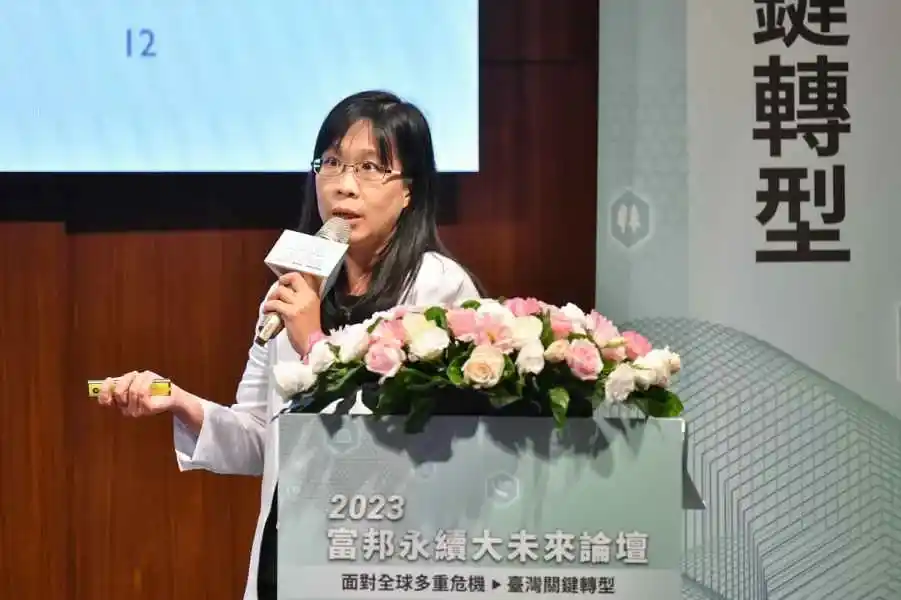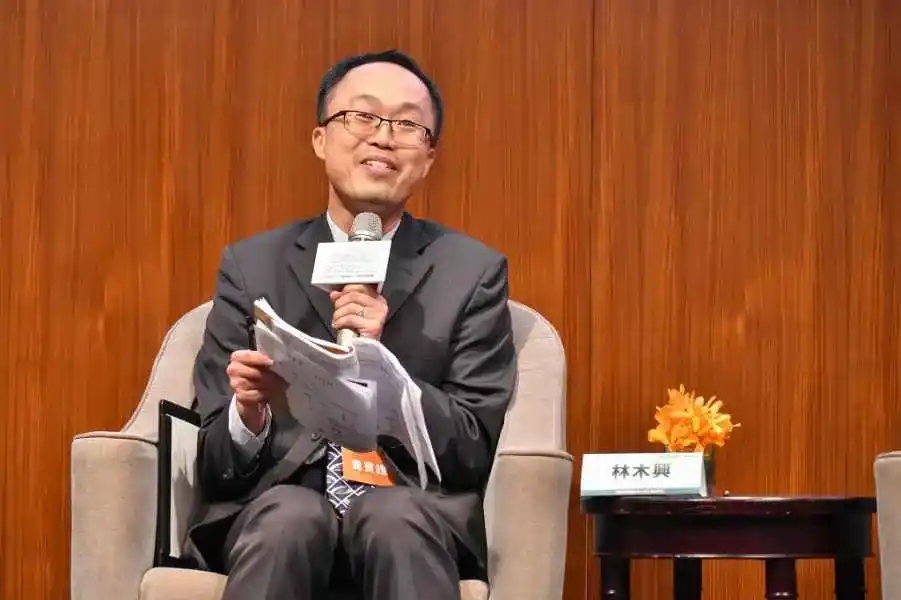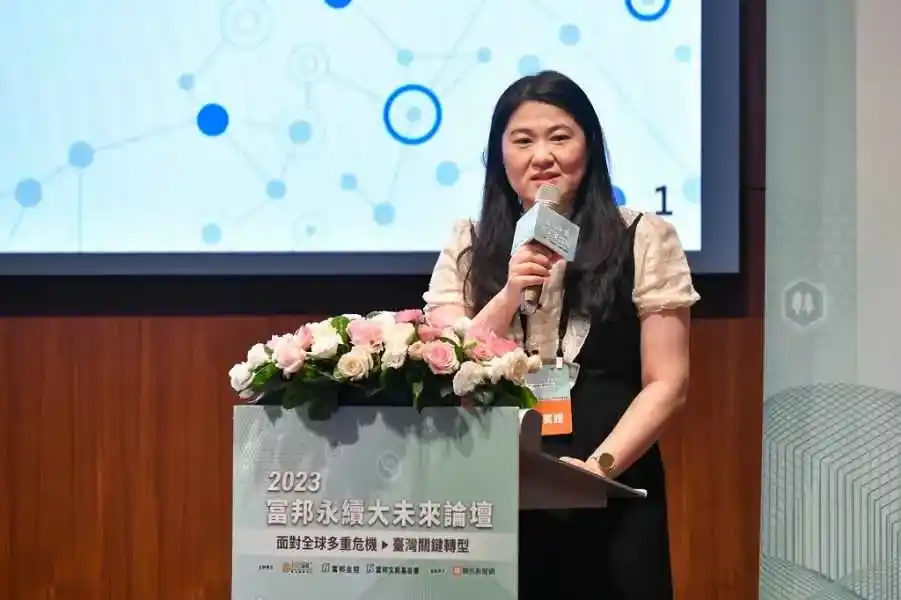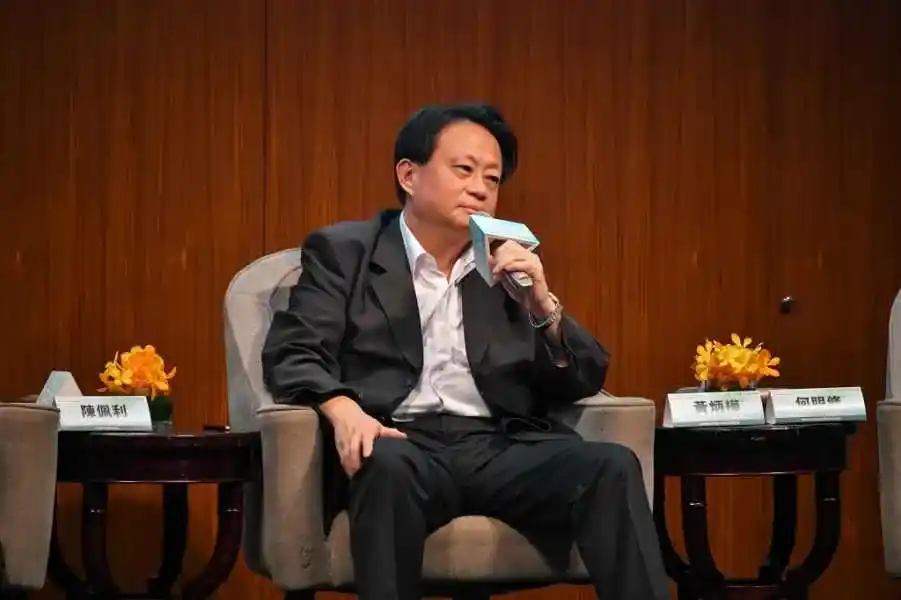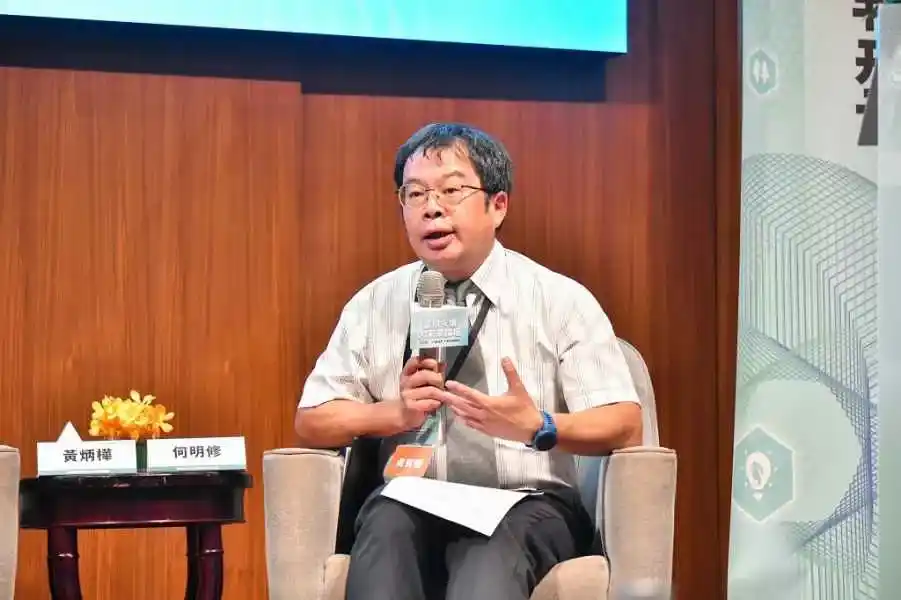In the second session that immediately followed, the industrial climate risk research team at the Risk Society and Policy Research Center of National Taiwan University (hereinafter referred to as "NTU RSPRC") addressed the key issue of "Task Force on Climate-related Financial Disclosures (TCFD)"for this forum, and released the "TCFD Survey Report: Challenges of Carbon Intensive Industries in Achieving Net-zero Transition". The survey release was hosted by Kuei-Tien Chou, Director of RSPRC, with the support of Postdoctoral Researcher Ya-Ting Kuo and Assistant Researcher I-Meng Chao who conducted the investigation. Dr. Kuo presented key findings of the survey and Postdoctoral Researcher Mu-Xing Lin joined the final discussion. The survey was conducted jointly by RSPRC, Fubon Financial Holding CO., Ltd., and the Center for Sustainability Science of the Academia Sinica. A total of 900 companies were surveyed from February to April of this year (2023).
The survey was introduced by Director Chou, who pointed out that Taiwan is currently immersed in a complex development context involving the EU's Carbon Border Adjustment Mechanism (CBAM), the US Clean Competition Act (CCA), carbon fees, carbon inventory, and emissions trading systems. Adding to this complexity is the International Sustainability Standards Board (ISSB) which aims to strengthen corporate resilience to face physical and potential climate risks by preparing to integrate external pressures of the Sustainability Accounting Standards Board (SASB) and TCFD framework. Therefore, the main challenge at present is to ensure that Taiwanese companies achieve more precise and procedural development for the TCFD framework. Chou provided a simple summary and analysis of the survey report results, pointing out that only 129 companies out of the 900 respondents have implemented TCFD. Less than 10% of the companies have set net-zero targets; less than 20% follow the TCFD framework; and 80% lack professional personnel for assessment. Moreover, there is still significant room for improvement in how companies cultivate talents in dealing with physical and transitional climate risks, and how they promote organizational, decision-making, and process innovation.
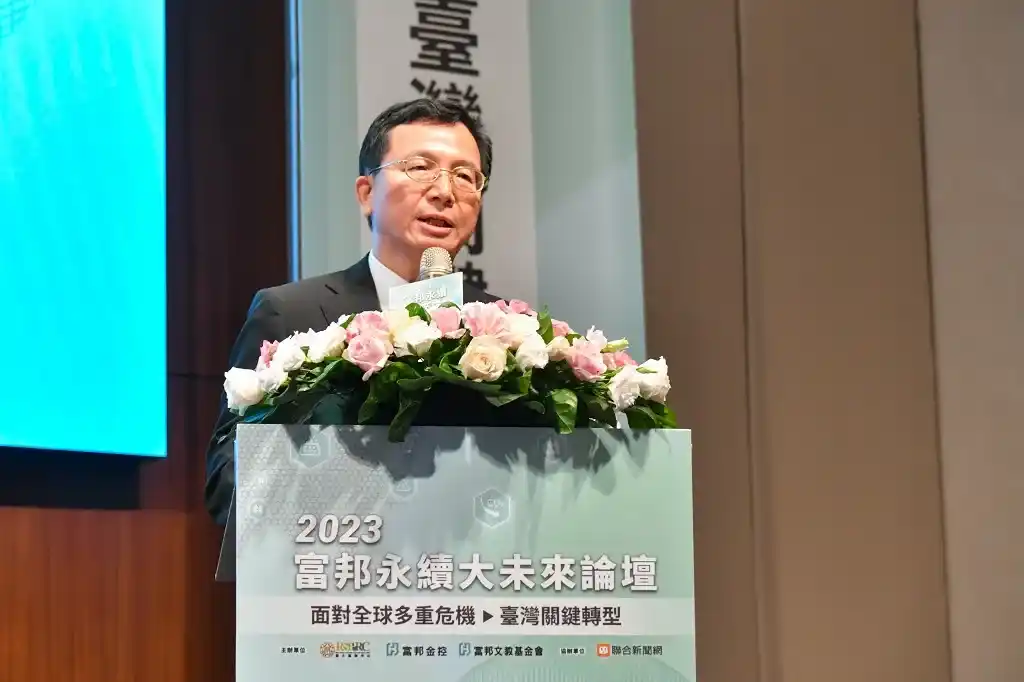
Dr. Kuo's report first addressed the background of the survey, pointing out the increasing trend in number of companies joining TCFD since 2017, both in Taiwan and rest of the world. According to the industrial statistics surveyed by the NTU RSPRC, Taiwan's information technology industry is the main player, in contrast to the global trend led by the financial industry. Since 2020, TCFD compulsory enforcement policies have been issued worldwide, including the UK, the EU, Switzerland, the US, Canada, Brazil, Egypt, New Zealand, Taiwan, Hong Kong, and Singapore. This further illustrates that countries are gradually realizing the impact of climate risks on business operations, thereby designating TCFD as a mandatory disclosure item for listed companies, financial institutions, and insurance companies. Echoing the introduction of the Green Finance Action Plan 3.0 by Vice Chairperson Jean Chiu of the Financial Supervisory Commission in the first session, Dr. Kuo pointed out that Taiwan's action process regarding the TCFD framework actually started early, including the Green Finance Action Plan 2.0 launched in 2020, the Green Finance Action Plan 3.0 launched in 2022, as well as this year's requirement for banks, insurance companies, and some listed companies to disclose climate-related information in their sustainability reports and annual reports.
Dr. Kuo proceeded to elaborate and expound on the survey report in detail. This survey included not only traditional carbon-intensive manufacturing industries, but also placed emphasis on the investigation of carbon-intensive electronic manufacturing industries in Taiwan, given the unique characteristics of the local industry. Business executives were the main subjects of the survey, accounting for 60.8%. The majority of these companies have revenues between 100 million and less than 500 million. These companies primarily face the market of Taiwan, while other markets include the EU, the US, and China.
Firstly, regarding the climate change perception of companies, the proportion of listed companies who have conducted TCFD is significantly higher than non-listed ones, and has shown a multiplier growth compared to last year, reaching 40.6%. The survey further inquired into the motivation for companies to promote the TCFD framework, and found that more than half (52.7%) of companies indicated compliance with government regulations, while only 31.0% saw it as an important business strategy. Meanwhile, for over 700 companies that have not yet implemented TCFD, the willingness to do so in the future is higher for companies that focus on international markets compared to those that focus on domestic markets, at 34.2% and 22.7% respectively; while the willingness of listed companies is also much higher than that of non-listed companies, indicating that policy pressure is prompting listed companies to take action.
Subsequently, Dr. Kuo presented the implementation status of the 129 companies that have implemented TCFD. The survey showed that in terms of governance, over 90% of the companies that have implemented TCFD are now supervised by the board of directors, a significant increase compared to last year (68.6%). Additionally, over 70% of companies have dedicated personnel and regular meetings specifically for TCFD. Furthermore, this year's survey also included a new question item, inquiring whether companies have linked climate-related incentive mechanisms with employee KPIs. The results showed that only 12.8% of all the 900 companies have incorporated climate actions into their organizational culture. However, the proportion is higher for companies that have implemented TCFD, highlighting the fact that companies implementing TCFD are more conceptually able to include employee KPIs in climate risk management strategies. In terms of strategy, more than half (53.5%) of the surveyed companies have conducted medium- to long-term climate risk assessments for over 10 years, but 8.5% have not yet conducted climate risk assessments. The survey also found that 62.0% of the companies have quantitatively analyzed the financial impact of climate risks and opportunities, 21.7% only have qualitative descriptions, and even 16.3% have not evaluated the financial impacts that climate change may incur. It is interesting to note that while this year, over half (50.4%) of the companies surveyed have applied scenario analysis to address various climate impacts, compared to last year (2022), the figure has increased. However, this also reflects that nearly half of the companies lack the ability to assess different climate risks through scenario analysis.
As for risk management, Dr. Kuo reminded that even though the National Science and Technology Center for Disaster Reduction (NCDR) has provided an open data platform, most of the companies conducting TCFD are still not using this platform when assessing physical risks. In addition, only 1.7% of the surveyed companies have introduced internal carbon pricing and internalized external costs (carbon emissions) in response to the changing international regulations on transitional risks. Even for companies that have implemented TCFD, less than 10% (7.8%) of them have implemented internal carbon pricing. Finally, in terms of TCFD indicators and targets, only 35.0% of the surveyed companies have actually disclosed their GHG emissions. Although the proportion of GHG emission information disclosure is higher among companies implementing TCFD, less than 40% (38.0%) have actually obtained ISO14064-1 certification. Furthermore, less than 20% (19.2%) of the surveyed companies have set a net-zero emission target, and less than half (41.9%) of those implementing TCFD have done so. Only about 10% (10.7%) of the companies have implemented carbon inventory for their supply chains, which means that the carbon management of their supply chains needs to be improve
According to the survey conducted by NTU RSPRC, after weighting and assessing the content of the TCFD proposed framework, only half of the traditional carbon-intensive manufacturing industry (53.3%) and financial industry keep in line with the TCFD framework. Lastly, regarding the framework for energy transition, low-carbon transition, and sustainable development, the survey report shows that despite the fact that policy is indeed a source of pressure for energy transition, about half of the companies (45.9%) do not feel the pressure to adopt renewable energy. Therefore, less than 30% (27.3%) of the surveyed companies have built renewable energy facilities, and less than half (45.0%) of them that have implemented TCFD have done so. The report suggests that the government should tighten regulations for large electricity consumers, expand the definition of large electricity consumers, and increase mandatory capacity limits.
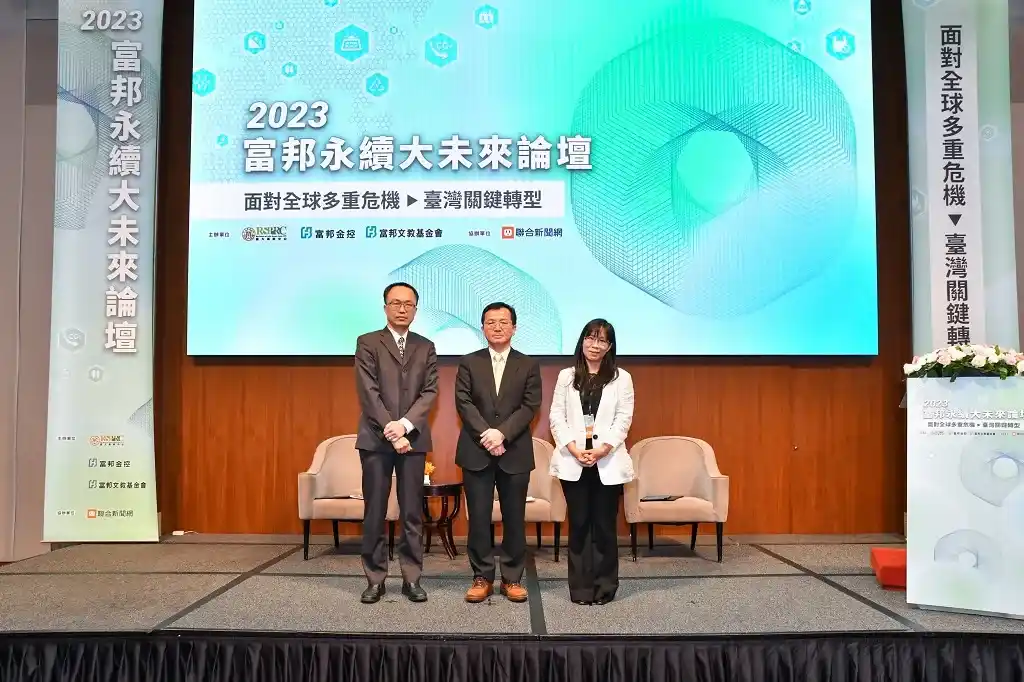
The survey also shows that a high proportion of companies that have implemented TCFD have taken low-carbon innovation actions. However, overall, less than 20% (13.7%) have carried out low carbon innovation in products, processes, marketing, or organization. Dr. Kuo emphasized that with the advent of low-carbon transition, it is imperative for the government to invest significant capital and expertise, and for businesses in the middle and lower reaches of the supply chain to collaborate so as to avoid being excluded from the low-carbon supply chain. In terms of talent strategy, 37.3% of the surveyed companies provide training courses for climate talents, and less than 20% (15.8%) recruit new talents, indicating that Taiwanese companies tend to train existing employees rather than recruit new talents. The survey also shows that 80% (79.9%) of the surveyed companies still lack professional manpower to assess climate risks. Therefore, to achieve net-zero emissions, it is necessary to strengthen the cultivation of relevant talents, realize the disclosure of climate risks, and embed climate action deep into the organizational culture, thereby building the climate resilience of companies.
Finally, in the aspect of sustainable finance, the vast majority of the companies are not required to provide climate-related information, but nearly 39.1% are willing to do so. At the same time, although most financial institutions (87.5%) are willing to provide favorable financing terms to companies with good climate-related ratings, only less than 10% (3.8%) of the companies actually receive favorable financing conditions. Dr. Mu-Xing Lin, who participated in the post-meeting discussion, further supplemented that this issue also highlights the transformation risk of Taiwan's TCFD trend in the legal context. It is currently a daunting challenge for Taiwan in its net-zero transition regarding how to amend laws such as the Company Law and the Securities and Exchange Act in order to move from soft guidance to a stronger regulatory framework. Therefore, Chou's final appeal emphasized that in addition to strengthening the political and legal positivity of climate-related data disclosure, the government must introduce strategies to make larger companies to assist smaller ones. Furthermore, there needs to be a joint collaboration between the government and companies, focusing on the organization, innovation, and talent training, while simultaneously implementing low-carbon transition through methodological and practical approaches to combat climate change risks. This is the direction of the future efforts.
The third session that took place in the afternoon, "Looking Ahead -- Risks and Opportunities for Overseas Taiwanese Businesses to Return to Invest in Taiwan", began with a presentation by Pei-Li Chan, Deputy Director General of the Industrial Development Bureau of the Ministry of Economic Affairs, on "Upgrading and Transforming Taiwan's Industries in the Net Zero Era." Chan indicated that the continuous interference and increased force of recent international geopolitical factors have contributed to Taiwan's overall negative export growth. The international situation of the Sino-US trade competition also shows that the world is moving toward two sets of supply chains, . Under this context, since 2018, the international supply chains of major factories have gradually moved from China to Southeast Asian countries such as India, Vietnam, and Thailand. While about half of the server supply chain is still in China, some high-end server manufacturers have relocated back to Taiwan. In conjunction with the "Action Plan for Welcoming Overseas Taiwanese Businesses to Return to Invest in Taiwan" which has been promoted over the past four years, the government has also assisted businesses in eliminating obstacles encountered when investing in Taiwan. In this regard, Chen stated that currently, the three major plans for investing in Taiwan are focused on assisting Taiwanese businesses to implement smart and low-carbon initiatives. In terms of effectiveness, over 1,000 manufacturers have fulfilled the conditions for "smart factory"; and the new action plan review starting from 2022 requires energy-saving and carbon-reduction planning. According to the statistics from the Industrial Development Bureau, of the 178 companies that have passed the new action plan, 70% have installed renewable energy equipment, and 60% have used energy-saving or low-carbon equipment. Through sharing the achievements of industrial transformation of businesses returned to Taiwan, Chan further emphasized the importance of policy guidance: once the government sets the requirements for smartization and low carbonization, it will prompt businesses to accelerate their adaptation to the national 2050 net-zero carbon emissions pathway.
Aside from the net-zero pathway at the national level, Chan also mentioned the transformation trend in the international supply chain. Judging from the annual procurement amount of more than USD 200 billion from international giants, Taiwan's unparalleled ODM services must comply with net-zero regulations for the supply chains of various global brands. Chan summarized four driving factors for achieving net-zero among companies, namely, government policies, customer requirements, market sales, and investment evaluations. Among these, investment evaluations are of paramount importance to a company's loan interest rates. In order to achieve low-carbon transition in manufacturing, three strategies should be implemented, namely, process improvement, circular economy, and energy substitution. As for how the information and communication technology supply chain can accelerate the process of net-zero transition through the introduction of intelligent technologies, Chan pointed out that the Industrial Development Bureau will continue to actively promote and strengthen the step-by-step strategies from computerization, equipment networking, visualization to AI simulation and decision-making to enable companies to control the daily production output. Finally, Chan shared the "Special Act for Enhancing Post-pandemic Economic and Social Resilience and National Sharing Economy Achievement" recently promulgated by the government, which aims to assist industries and small and medium-sized enterprises (SMEs) in upgrading and transforming. She explained the systematic strategy for promoting the net-zero transition of the manufacturing sector and expressed the hope of combing industry association forces to implement guidance measures for larger companies to lead smaller ones, with subsidies provided by the government for consultation and diagnosis of companies' carbon footprints and carbon inventory. At the same time, the government will also provide subsidies for the overall upgrading and transformation of the industry chain, and offer free talent training courses for low-carbon and intelligent development, in efforts to build a new era of diversified industries.
The second speaker was Bing-Hua Huang, General Manager of Tung Ho Steel Enterprise Corporation, who brought out Taiwan's current dilemma in balancing environmental concerns and industrial competitiveness with the topic of "Constructive Dialogue and Compromise Measures". He pointed out that when industries aim to reduce carbon emissions, the primary task would be to implement carbon inventory, especially since Taiwan's energy emissions make up 90.4% of the entire emissions structure, with the sector of electric power accounting for 56.4% of these emissions. Therefore, when we confront net-zero transition, it is inevitable to address the issue of electric power. The solution proposed by Tung Ho Steel is to replace the existing fossil fuels by mastering the cost of power generation through renewable energy, including the power generated from wind, solar, and biogas, and to establish economically viable power generation methods. In terms of fuel, Tung Ho Steel is looking forward to developing hydrogen and green ammonia; and even carbon capture, utilization, and storage (CCUS), which was referred to by Huang as the "last mile" toward net-zero emissions. Huang also acknowledged that investing in renewable energy is currently the only cost-effective solution, and other options are impractical in terms of cost considerations. For this reason, he advocated that we cannot completely abandon the option of nuclear energy, and the use of nuclear energy may be a necessary path toward net-zero carbon emission by 2050.
Viewing nuclear power as one of the necessary solutions forenterprise transition, Huang further questioned from the opposite angle, whether following the current development of distributed power generation plants, could hydrogen provide more resilience for enterprise transition at the usage end in addition to being classified as a form of renewable energy? In terms of carbon emission, nuclear power is undoubtedly a form of carbon-free electric power that can be used to produce pink hydrogen without carbon emissions. For Tung Ho Steel, the first priority in facing low-carbon transition is "energy conservation". Energy emissions stem from electric power and fuel sources, in which electric power needs to shift toward renewable or carbon-free power, while fuel must be electrified as much as possible, because the former is already cost-effective. Huang also emphasized the importance of electric power in maintaining people's livelihoods, economic development, industrial competitiveness, and environmental sustainability. He also shared Japan's experience of having to include nuclear power in its future energy strategy despite a painful nuclear disaster, noting that the reasons behind such an energy policy are worth pondering on. Lastly, unlike many companies that follow global renewable energy initiatives and set RE100 targets, Huang pointed out that Taiwan's renewable energy plan also falls short of the RE100 target, based on the RE30 put forth by Tung Ho Steel. Huang concluded that in the process of carbon reduction, Tung Ho Steel supports any carbon-free, low-cost electric power and energy, which is the true sustainable path for companies.
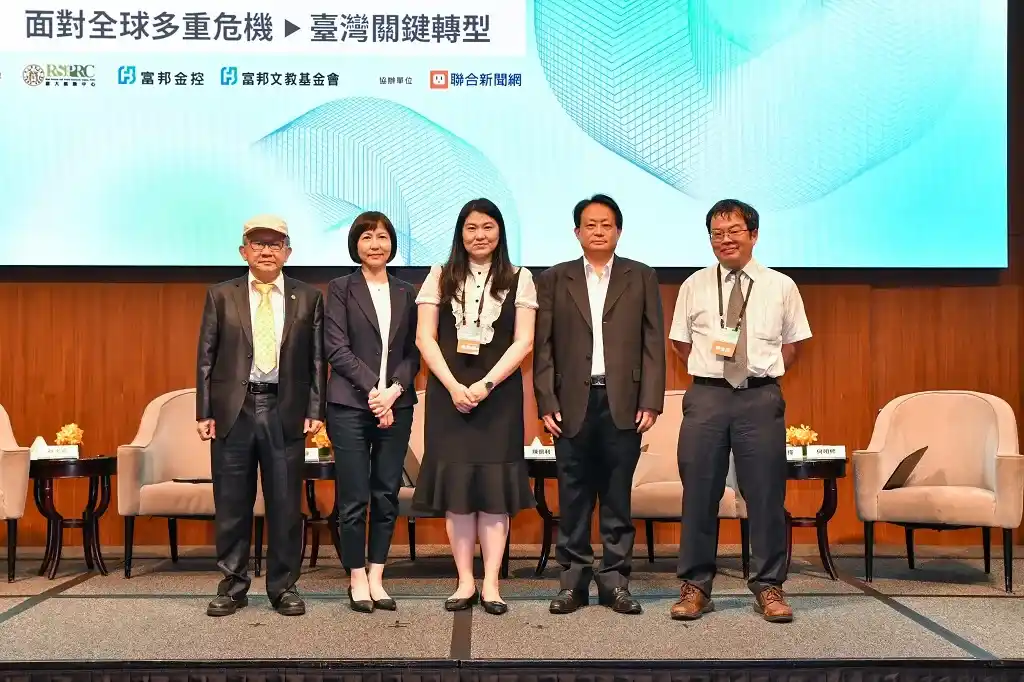
The third speaker, Chih-Hung Tsai, Chairman of Taiwan Water Resources Conservation Union (TWRCU), attempted to discuss the implications of the current situation of water resources utilization in Taiwan for re-evaluating the government's three major plans for investing in Taiwan from the unofficial perspective of an environmental organization. Starting from the reality that although Taiwan has abundant rainfall, the average water usage per person is low due to its topography and dense population, Tsai questioned why Taiwan -- known for its water scarcity risk -- has a water price far lower than the average level in other countries. This low water price not only causes financial problems for water supply companies and increases water leakage but also hinders water conservation and the use of recycled water. While it is commonly believed that reservoirs have the highest water supply proportion (22%), the actual rate of groundwater extraction (32%) is much higher, indicating that the government has failed to observe the depletion of underground water reserves despite having spent a significant amount of money on reservoir management. According to Taiwan's water usage structure and industrial water consumption, industrial water usage cannot be reduced even during drought periods though it only accounts for 9%, with chemical, electronics, paper, basic metals, textiles, and petroleum industries being the six major water consumers. While agricultural water usage occupies 73%, it can be temporarily suspended during droughts. Aquaculture water usage accounts for 7%, but most of it comes from groundwater, causing problems such as stratum subsidence. Tsai also showed that the rainfall in southern Taiwan is significantly lower than the national average during drought periods, highlighting the significant water shortage that companies must face when establishing factories in the south. Furthermore, Tsai pointed out that due to over-pumping of groundwater (up to 1.5 billion tons per year) in central and southern Taiwan, subsidence is continuously occurring.
Tsai further questioned the land use planning and estimation of water demands, which predict that industrial water demand in all regions of Taiwan will rise. Such an estimation not only holds that the population will inevitably grow and industrial parks will continue to increase, which seems far from reality given the decreasing birth rate. Tsai also argued that water recycling plants may be an important resource in the future to solve industrial water shortages. The recycling of domestic wastewater, unlike reservoirs, can effectively alleviate the water supply pressure during droughts. However, he also cautioned that low water prices may restrict the development of water recycling plants. Therefore, how to promote reasonable water pricing, strengthen financial sustainability, and enhance water-saving and recycling through institutional measures are key issues that the public and private sectors must work together to solve in the future. In the concluding part, Tsai presented suggestions to the three major plans for investing in Taiwan based on the aforementioned water resource utilization dilemmas and opportunities. He believed that if the government only focuses on the total investment amount and ignores the consumption of resources such as water and electricity and carbon emissions, Taiwan will face crisis and catastrophe in the future as it has already reached the limit of resource utilization. In addition, when reviewing investment applications, it is necessary to also consider the water consumption, carbon emission intensity, energy intensity, and water pollution discharge coefficient of the projects and not only focus on their carbon reduction plan. Under Taiwan's low water and electricity price system, the country should also avoid accepting high-water and high-energy consumption industries eliminated by China to prevent becoming a pollution industrial zone for other countries.
The final speaker was Jing-Jing Liu, Chief Sustainability Officer of Acer Incorporated, who shared Acer's experience in sustainability and low-carbon transition. Regarding Acer's sustainability, Liu emphasized that Acer's corporate mission is to continuously think about how to shorten the distance from customers to products and technology. Sustainable business practices and continuous innovation are inseparable. Acer's innovation mainly focuses on two themes: first, expanding the user base of core products, including potential consumer groups such as e-sports streamers and video creators; second, focusing on social issues, especially the UN's 17 Sustainable Development Goals (SDGs), including Goal 3 (good health and well-being), Goal 11 (sustainable cities and communities), and goal 13 (climate action). Acer has also excelled in multiple sustainability rankings. In addition to reflecting on its sustainability performance, Acer considers sustainability rankings an important tool for managing sustainable business because of its "objectivity" and "sustainability leadership." Acer's sustainability leadership is evident in the company's various sustainability initiatives, such as the carbon inventory of its global operations that started in 2008, the renewable energy purchasing program in 2011, the third-party carbon inventory in 2012, and the inclusion of supply chain carbon management performance in supplier scorecards since 2013. Acer's senior executives would discuss with supplier executives during business meetings on how to strengthen the latter's carbon management performance. Based on these efforts, Acer announced in 2021 that it aims to achieve the RE100 target by 2035, with the Group as a whole has already reached the milestone of RE45 in 2021.
Liu continued to share Acer's energy transition strategy, which focuses on energy conservation as the premise, followed by the use of self-built solar installations, and finally, the purchase of renewable energy and renewable energy certificate (REC). After discussing the operational aspect, Liu emphasized the two core areas of Acer's product strategy, namely, reducing carbon emissions and promoting a circular economy. This includes increasing the proportion of recycled materials used in product casings and using touchpads made from recycled ocean plastics. Managing power consumption efficiently is also currently a key focus in Acer's product development. Through the design of green products, Acer aims to lead material development by creating demand for use in volume, thereby shaping a more circular economy-oriented product eco-chain. As one of the few CDP supply chain members in Taiwan, Acer has been leading its suppliers to conduct carbon inventory since 2008 (currently the third-stage suppliers have been introduced). In recent years, Acer has encouraged its suppliers to propose more diversified sustainable solutions for Acer's products and services.
During the comprehensive panel discussion, an audience member asked how SMEs can increase their proportion of renewable energy use under Taiwan's industrial structure, especially since it is much easier for large companies to meet the RE100 target than SMEs. Therefore, what specific plans do relevant organizations have to "make larger companies to assist smaller ones"? In response, Deputy Director Pei-Li Chan suggested that SMEs, even those who do not participate in the government's subsidy programs, can start by reviewing their electricity bills as there is a certain correlation between electricity bills and carbon emissions. The government has also provided a digital carbon emission calculation platform called "Jin Hao Suan" to encourage SMEs to use it in conjunction with their electricity bills to achieve carbon reduction from energy saving. In addition, Chan believes that Taiwan's SMEs already have a strong ecosystem. Thus, the most promising approach is to make large companies to assist smaller ones and include SMEs in supply chain management, mutual learning, and observation. General Manager Huang reminded that RE100 is the necessary path to achieve net-zero carbon emissions by 2050 for both SMEs and large enterprises. On such a path, Taiwan's electricity consumption must be adjusted, not only in price, but also in the overall structure. Only by making structural adjustments to time-of-use pricing can we change the electricity usage habits and ultimately resolve energy distribution problems. Chairman Chih-Hung Tsai also mentioned that SMEs should re-examine their energy-saving methods and review whether their plants have the potential to develop renewable energy and circular economy initiatives. The achievement of Taiwan's goal of net-zero carbon emissions by 2050 is only possible if energy conservation is done well. Chief Sustainability Officer Jing-Jing Liu suggested that, to set a carbon reduction target, companies should make good use of government and customer resources and first conduct carbon inventory to determine their carbon emissions baseline. In addition to expanding external communication, setting carbon reduction target can also help shape internal consensus within the company and incorporate the target into the relevant decision-making across departments.

This work is licensed under a Creative Commons Attribution-NonCommercial-NoDerivatives 4.0 International License.
※The aforementioned may not be copied for commercial use without the center's consent, thank you.※


